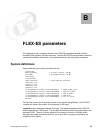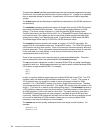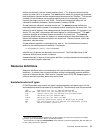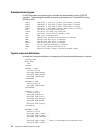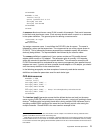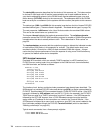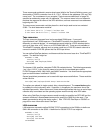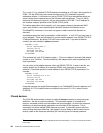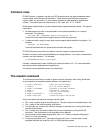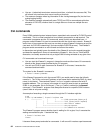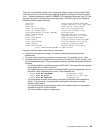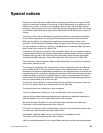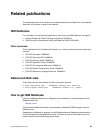Appendix B. FLEX-ES parameters 81
Common rules
FLEX-ES names, in general, may be up to 255 characters and use upper/lowercase letters,
numeric digits, and a few special characters. These special characters are underscore,
hyphen, dollar, at, and period. A name cannot consist of a valid decimal or hexadecimal
number. The following are not valid names: 2, 123, 1403, 0X1, 7F, 7f, 1C2a30.
White space (usually blanks) may be included almost anywhere between words. Two special
cases exist:
No white space may exist in the parameters of an options statement or in a devopt
parameter. For example,
device(00) 3390-1 /S390/VOLAs1 devopt ‘trackcachesize = 10’
is incorrect; there should not be spaces before or after the equal sign.
If a device number range is used, there must be spaces before and after the hyphen. For
example:
device(00 - 15) 3278 OFFLINE
is correct because there is a space before and after the hyphen.
FLEX-ES keywords cannot also be used as names in system or resources sections.
Numbers (in system and resource definitions) are always decimal. If you want a hexadecimal
number, you must indicate it. For example:
cu devad(0xA80,10) path(1) resource(xyz)
contains a hexadecimal number (0xA80) and a decimal number (10). CLI commands differ;
they assume device addresses are hexadecimal.
You should not use duplicate names in any definitions.
The resadm command
The resadm command has a number of options that are frequently used. Using R10A.rescf
as an example of a compiled resource definition, the options are:
# resadm -s R10A.rescf (start the resource manager)
# resadm -k (kill the resource manager)
# resadm -t cu:cu3990A (terminate an individual resource)
# resadm -T (terminate all resources)
$ resadm -r (list all active resources)
$ resadm [-h hostname] -n (list node names)
# resadm -x R10.rescf (refresh the resource definitions)
A few notes about the resource manager may be useful:
The -r and -n options may be used by anyone. The other options are available only to root.
The -r option is the most frequently used option.
For all except the -s option, the resource manager is assumed to be running when these
commands are issued.
The -n option is for use when multiple Servers are cooperatively running FLEX-ES
resources. This environment is not described in this redbook.
You should terminate resources gracefully, with -t or -T options, instead of killing them
(with -k or Linux commands).
A common sequence is to -T (terminate all resources), then -x (refresh with a newly
compiled resource file), and then re-IPL a S/390 operating system.



